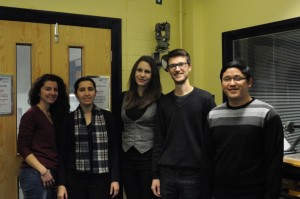This September saw 5 new PhD students join the Geospatial Engineering group, working in the field of remote sensing and photogrammetry. Magdalena Smigaj is a NERC-funded student working with Forest Research and examining ways to improve early detection of tree health problems, with a focus on detection of disease in UK forests using airborne imagery, LiDAR and data from an unmanned aerial vehicle (UAV). Originally from Poland, Magdalena obtained a BSc in Surveying and Mapping Science from Newcastle University before commencing her PhD. Maria Peppa is jointly funded by the British Geological Survey and EPSRC, and is investigating the potential of UAVs for landslide monitoring, with focus on photogrammetric aspects. Originally a native of Athens, Greece, Maria recently completed a two year MSc in Geodesy and Geoinformatics at The Royal Institute of Technology, Stockholm, so has traded one chilly climate for another in her move to Newcastle. Elias Berra has come to Newcastle following a Masters in Remote Sensing at Universidade Federal do Rio Grande do Sol (UFRGS) in Brazil. Elias is funded by the Science Without Borders programme and will be developing methods for monitoring woodland phenology (seasonal changes) using the School’s UAV. Elias, Maria and Magda will be working together over the coming weeks and months to develop more practical skills related to piloting and planning UAV flights. Polpreecha Chidburee, who goes by the nickname of Aun, is a Thai-sponsored PhD student who will be developing a close range photogrammetric system for rapid assessment of slope instability hazard. Aun is expected to work closely with Maria and a number of other CEG PhDs focusing on slope failure challenges. Finally, Afrah Daham is the latest in a line of PhD students to join the group from Iraq. Afrah, who is sponsored by the Iraqi government, joined the group from the University of Baghdad, where she was a lecturer in photogrammetry. Afrah will be researching the field of feature extraction and building reconstruction from mobile laser scanning data, exploiting a unique mobile mapping dataset acquired for the Newcastle University campus over the summer of 2013.

